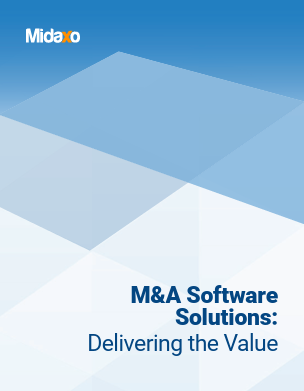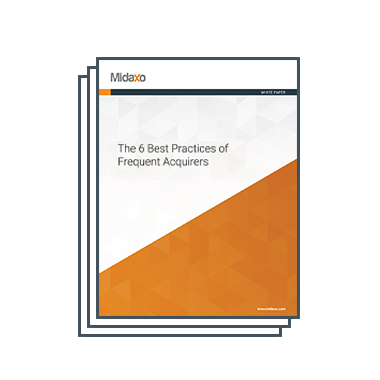Introduction:
Virtual data rooms (VDRs) gained popularity around 2001 and have become an increasingly popular tool for mergers and acquisitions. In fact, every day hundreds of people search for VDRs via the internet. Here is the problem though when it comes to M&A and virtual data rooms: while they have transformed the ability to secure sensitive documents, VDRs alone do not transform a company’s M&A process.
Yes, efficiency and transparency are benefits of a VDR, but unless your VDR has additional functionality designed by M&A experts specifically for M&A, you are basically doing deals in the Dark Ages. Moreover, if your deal team is fairly green or stretched thin, relying solely on a VDR is a major red flag in your deal process. With this in mind, below we discuss where specifically VDRs fall short and why the shift to M&A software will elevate your M&A practice.
Where VDRs Fall Short:
We must begin by stating what should be obvious: a virtual data room is not M&A software, although many VDR companies out there would like you to believe that is what they are supplying – just do a quick Google search and see all the VDRs with virtually no M&A functionalities that come up. More specifically, VDRs have the following downfalls when it comes to enhancing your deal process and significantly impacting the quality and efficiency of each stage of the deal lifecycle:
- Lack of process management tools – A virtual data room is not all that different from a physical data room. It stores documents securely for its clients. Of course, a virtual data room does allow for virtual collaboration, which offers the major benefit of reduced time and money spent on travel since business can literally take place anywhere, 24/7. In addition, if the VDR offers document tracking, indexing, and thoughtful search functions there are added benefits related to efficiency and transparency, but this does not mean the VDR is upgrading how you approach deals since it lacks critical process management tools that assist in realizing full deal value.
- Limited benefit on due diligence – As noted above, storing and reviewing documents during due diligence are benefits of VDRs, but by using a VDR for M&A deals, you are not enhancing your ability to conduct thoughtful due diligence. Real time analytics, progress reports, and editable playbooks are just some of the features missing from most VDRs, but these are all required to enable and foster a truly high functioning due diligence team.
- Negligible impact on post merger integration – Since VDRs are often shut down by practitioners after due diligence, the opportunity to communicate and build on the information is, in many cases, wasted. Many VDRs do not allow practitioners to flag key items for integration planning.
How M&A Software Differs From a VDR:
M&A software, especially when paired with a compatible VDR, is the best bet for M&A practitioners, whether they are mid-market acquirers with small deal teams or Fortune 500 companies well-versed in deal-making. Specifically, M&A software offers a wide range of benefits; some of the most notable are:
- Full pipeline set-up — This not only simplifies the entire process management for deal teams, but also allows for one tool to be leveraged to track all deals. Oftentimes, a VDR is used for diligence, then the information is extracted and practitioners revert to using a variety of tools and/or platforms; this brings more complexity to an already complex and often chaotic practice. By selecting genuine M&A software versus a VDR, you are setting up your teams for success before, during, and after due diligence.
- Target scoring — At the beginning of the deal lifecycle, M&A software will help with target monitoring and scoring. For instance, solid M&A software should provide an initiative dashboard, allowing teams to visualize all targets. Moreover, to be a truly valuable tool, the software must have functionality related to target scoring based on a set of specific strategic and financial criteria, which will ultimately allow you to identify best fit prospects in a more efficient, evidence-based manner. Improved target scoring also aids in the creation and communication of the deal thesis so Corporate Development can clearly and concisely support the target to the CEO and/or Board.
- Real-time analytics & robust data integrations — With one source of truth for your entire pipeline, real-time analytics are not only possible, but also very meaningful. These analytics allow for another organizational, time-saving, and informed decision-making benefit: click-of-a-button reporting. Bonus points if your M&A software includes an integration with a powerful tool like PowerBI, which allows you to generate reports and custom dashboards automatically, saving hours of manual work.
- Click-of-a-button reporting — A key benefit of M&A software is its simple reporting structure, which has the ability to produce one pagers at the click of a button in order to easily communicate key information. The impacts of this reporting span all aspects of the deal lifecycle, with specific benefits seen during target sourcing, due diligence task tracking, and early integration planning. Some common uses of the M&A software reporting functionality include: due diligence reports by workstream/team and summary reports for the integration management office (IMO).
- Early integration planning — When a VDR is used instead of M&A software, critical information is often not communicated to the integration team since the VDR is closed out after due diligence; as a result, some key information can be lost or forgotten. M&A software, with its one tool approach for the entire deal process, safeguards against this. More specifically, features such as the ability to flag critical information for integration and an Integration Management Office dashboard are worth their weight in gold as they allow for a bird’s eye view of the entire deal process and provide a methodical workflow.
- Increased M&A process consistency — M&A software creates a seamless, organized, transparent, and informed M&A process from one deal stage to the next. Some platforms also include playbooks that provide a strong foundation for practitioners to alter and update deal actions as they conduct “lessons learned” retrospectives after each deal.
- Live KPI tracking — Comprehensive software also allows you to track financial and operational performance at the initiative, work stream or overall program level. One platform, one place for everything.
How a Comprehensive M&A Software Can Transform Your Practice:
- Instead of cobbling together point solutions, a complete M&A platform allows you to establish a single source of truth for your deal-making. Manage strategic reviews, sale preparation, engagement with potential buyers, correspondence tracking, document sharing, deal transaction closing, and project management of the separation process — all in one place.
- The efficiency and accuracy of this approach for practitioners cannot be overstated. With a complete M&A product offering, you can save time, leveraging one platform for the entire deal process versus moving back and forth between Excel, emails, and a VDR.
- Additionally, such software supports all deal types – from the simple sale of a stand-alone business to a major carve-out requiring complex legal arrangements and a full disentanglement process.
Final Considerations:
As you shop for effective tools to amplify your M&A process, do not be fooled by VDRs claiming to do more than store and organize documents. Remember, M&A software is more than a VDR, and, in our increasingly remote and virtual world, investigating and choosing the right M&A software platform for your deals is more important than ever.





